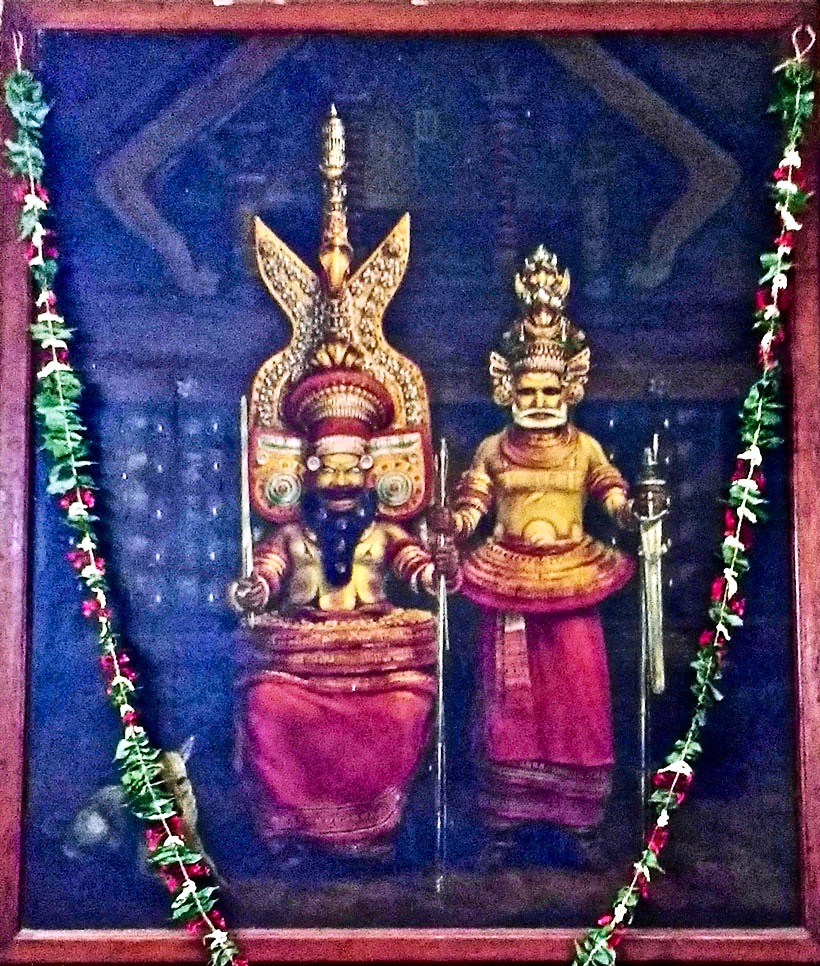
Sri Mutthappan Temple
Sri Mutthappan is a historical character like Sri Ayyappan. His advent took place around the same time. His temple is in a place called Parassinikadavu on the Valapattanam River, close to the town of Kannur in Kerala. The story of his advent in this holy land of Kerala, is quite fascinating. About five hundred years ago there was a well known “illam” (which is a Namboodiri household in Kerala), known as Ayyankara. The head of the family was Vazhunnavar and his wife was Padikutty. (The Brahmins of Kerala are known as Namboodiris.) It was a flourishing household and the couple had no dearth of worldly goods but unfortunately they were not blessed with progeny. Padikutty was a great devotee of Lord Shiva and used to go to the Shiva temple of Payyavoor daily. Every morning she would get up very early and go to the Payyavoor River along with her seven maids to have a bath before going to the temple. Her constant prayer to the Lord was to bless her with a son. One night she had a dream that Lord Shiva came and blessed her. Next morning when she went to the river and dipped she felt some sort of thrill going through her. Again and again she dipped and again and again she was filled with ecstasy. When she came up she suddenly spied a basket woven out of green coconut leaves floating on the water. The basket came and rested on a rock on the river banks. When she looked into the basket she saw an enchanting baby boy filled with an aura of divinity lying inside, kicking his tiny feet and gurgling with joy. She gathered the treasure into her arms and dashed back to the illam. She showed the baby to her husband with these words, “Itu Mutho Appa!” “Oh! God This is a pearl!” Somehow this name stuck and he was called Muthappan. Her husband was also delighted and decided to adopt the child as it appeared to be a gift from Lord Shiva. The child was given all the Vedic learning which is most necessary for a Brahmin child. However as the child grew up the parents found to their horror that the child showed total disinterest in Vedic studies and always ran off to play with low caste boys of the village. Soon he became an expert in archery. He would shoot birds and go fishing with the boys. Along with these boys he would eat meat and drink toddy (fermented drink tapped from the coconut tree). The villagers were horrified to see the son of their Brahmin chieftain resort to such low caste pursuits and complained to the father but unfortunately, his father could not deter him from his shocking ways. Unable to bear the behaviour of his beloved son, Vazhunnavar decided to leave the house and go to the forest. He spoke bitterly to his wife. “I cannot bear this disgrace anymore. I am leaving. You can live here along with your beloved son.” On hearing these shocking words of her husband, Padikutty fell down in a faint.
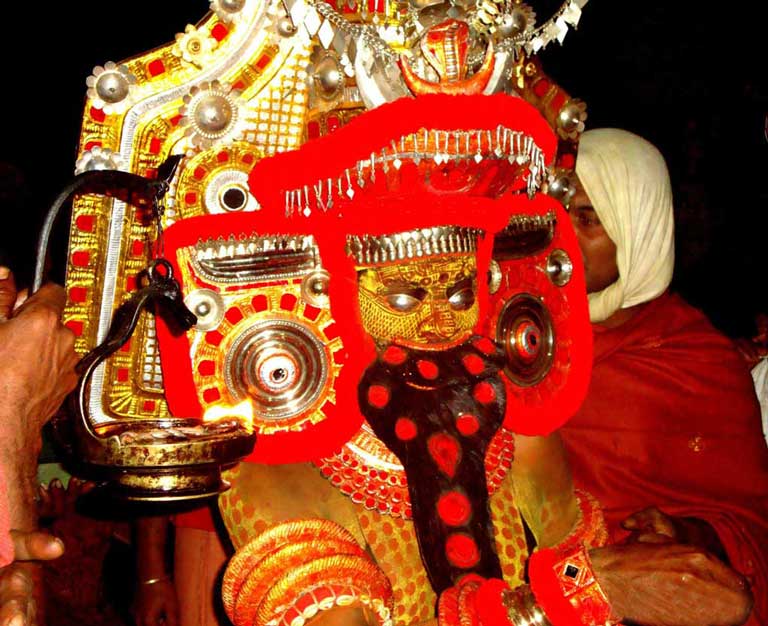
Mutthappan heard this conversation as he
entered the house and saw his parents’ plight. Without a word he went
into his bedroom and locked the door. The mother rose up from her swoon
and went towards the door but the door swung open of its own accord. The
parents were amazed at the sight. Instead of their son, they saw a
bearded man dressed as a hunter, carrying a bow and arrows. His eyes
were burning orbs of molten gold emitting sparks. There was fire
everywhere ignited by the sparks being shot out of his eyes. The
terrified mother begged her son to return to his original form. He
closed his eyes and the fire burnt down. The parents began to understand
the divine nature of their foster son and realised that he was showing
them his “viswarupa” or universal form just like Lord Krishna had showed
his true form to his parents in the dungeon when he was born. Padikutty
realised that he must be an incarnation of Vishnu himself.
Mutthappan told them that he had taken on this incarnation to help the
poor and downtrodden amongst the lower castes and that they should not
try to stop him.
In those days the Namboodiris used to be very cruel to the lower castes. They would not even walk on a road on which some low caste was walking. His servant would run before the Namboodiri and shoo off any low caste who dared to walk there. Mutthappan’s incarnation was to teach the Namboodiris a lesson – that God did not discriminate between high and low. But unfortunately they never learnt this lesson for many centuries which is what has led them to their present plight.
Mutthappan blessed his parents and proceeded to the forest known as Kunnathurpadi. He had a black beard and was clad like a hunter, in black clothes with head covered with a cap of peacock feathers, carrying a bow and arrows in his hands. Kunnathurpadi was a delightful place. It was filled with sugar cane plants round which bumble bees buzzed, tall coconut palms and another type of sweet palm tree which produced a delicious intoxicating drink like toddy. As was his custom Mutthappan used to climb this palm tree and drink the delectable toddy every day. The two tribals who used to tap this palm tree now started to suspect each other of having stolen the toddy. The elder one called Chandan decided to catch the culprit and hid in the trees armed with bow and arrows. In the morning he saw a bearded man quickly scramble up the tree and help himself to the intoxicating drink. Chandan used the most scurrilous language and shouted to the man to come down immediately. Mutthappan totally disregarded the barrage which was directed at him and continued with his pleasant occupation. This enraged Chandan even more and he pointed his arrow at the miscreant. Before he could shoot, Mutthappan turned his piercing glance at him and immediately Chandan froze into a stone figure. Wondering at the long absence of her husband, Chandan’s wife came to that spot and was shocked to see her husband turned into stone. When she looked up she saw a bearded man sitting atop the palm tree laughing at her. His fame had preceded him and she recognised him immediately and said, “Oh! Muthappa!” and vowed to give him roasted fish and the toddy of the sweet palm tree if he released her husband. Hearing the rather unusual bribe offered by the poor woman which was entirely to his liking, Mutthappan immediately released her husband. After this he continued to stay on in that enchanted forest with the tribals for some years.

He knew that the goal of his life was still to be realised so he left his friends and proceeded to the hill called, “Pularimala”, which was part of the domain of the kings of Kottayam who were the arrogant rulers of that place. They owned everything and behaved in a most cruel fashion to all the citizens. When they heard that the king was coming in his palanquin, the citizens would run helter skelter and take shelter wherever they could to avoid being seen by him. It was high time that something was done to stop this cruel king and that is why Mutthappan decided to go there.
He proceeded towards the king’s fortress called Harischandra Kotta. He subdued him completely. The king agreed to look upon Mutthappan as his king. Mutthappan reinstated him as the ruler on condition that he stopped harassing the low caste people and treated everyone with equal respect.
Once Mutthappan was resting under a tree after his various victories. When he rose up to go he picked up his bow which had got stuck on an ant hill. He pulled the bow out and the ant hill opened to reveal a divine sage totally covered with ashes. The sage accosted Mutthappa as “Narayana!” and Mutthappan in turn called him “Cherukka!” From that time onwards the two of them travelled together. He is known as “Cheriya Mutthappan” and is supposed to be the incarnation of Lord Shiva just as Mutthappan is the incarnation of Vishnu and is known as “Valiya Mutthappan.”. “Cheriya” means “small” and “valiya” means “big” in Malayalam.
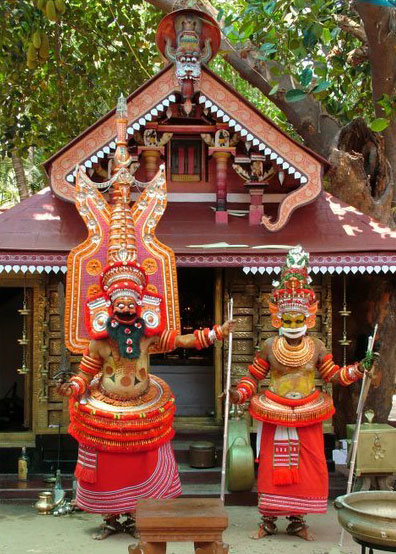
Mutthappan now decided that it was time for him to establish his cult and make a temple for both of them. He is said to have sent an arrow to a distant place. The arrow plunged into a tree at the place called Parassinikadavu on the banks of the beautiful river called Valappattanam which is 16 kms from the town of Kannur.
This arrow was spotted by a man from the Madayan caste who was a great devotee of Lord Shiva. The arrow was glowing with an ethereal light and the man knew that it must be a divine weapon. “Whose could this be?” He thought to himself and immediately Sri Mutthappan appeared before him. He ran to get the chieftain of their clan who came immediately. Sri Mutthappan gave him also the divine vision of himself before disappearing. He ordered them how to go about the establishment of his temple. After this he vanished and no one was ever able to find his body or trace his disappearance. These people were the last to see him in a human form.
The two men now cleared the ground round the tree where the arrow was still sticking. They kept a stone there and started offering worship to it. The food offerings were of fish, wrapped in banana leaf and roasted on hot coals and toddy from the sweet palm which were Mutthappan’s favourites. Muthappan had decreed this to be his preferred food in defiance of the normal offerings of the Namboodiri clan. He wanted to establish the fact that God accepted whatever was offered to him with love. We always offer whatever we find delectable to God. These low caste people loved fish and toddy. That was their staple diet. Naturally Mutthappan declared that he also liked the same things. Realising that the arrow was divine and had been sent by the divinity that had appeared before their eyes, the two men started worshipping the stone. First they made a small temple above it. They were the first ones who started the worship of Sri Mutthappan even though they were not Brahmins.
This tradition has continued to this day. The man who does all the pujas is known as Madayan after the first Madayan to whom he showed himself. The progeny of this family are the ones who do the pujas and also they are the ones who enact the drama of Big Mutthappan and small Mutthapan. In course of time the temple grew in size and had a roof put over it and so on. The two idols which are worshipped here are considered to be of Vishnu and Shiva.
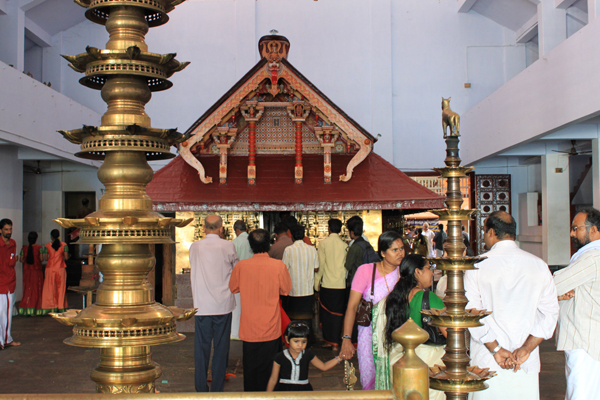
We reached at twilight and I was really charmed by the river which gurgled and flowed right in front of the temple. It was quite a delightful sight especially since the sky was tinted in pinks and purples by the setting sun. We went to wash our feet in the translucent water before entering the temple. It was rather a strange looking temple. It had a huge sort of hall all round it and one could see that the actual temple was a small, cute one right in the middle. Lots of people were sitting on either side of the hall on raised platforms. Men were seated on the right and women on the left. However I went in and peered into the sanctum. It was right in front of me and not far away as it normally is in most temples. I could easily put my hand in and touch the idols. The idols were quite strange. One was of a bearded man carrying a bow and arrows and the other was one of a person with a huge stomach, obviously “Valiaya Mutthappan and Cheriya Mutthappan”. A man wearing just a piece of cloth was doing something inside. As he came out I asked him if there was anything which could be offered here. He made vague gestures and drew a red cloth in front of the figures thus blocking the view. The others in my party said, “We are lucky to have had darshan before the temple closed so now let us go.”
I said, “But what about all these people who are sitting obviously waiting for some event. Let me ask someone.”
I went out and asked the office about this. They were most uninformative. They vaguely said that he veil would be opened only at 6.30 pm and we could wait if we wanted to! Further questioning uncovered the fact that the main method of worship here was the enactment of a ritual in which one or both the characters known as Muthappan enact a sort of dance drama through a traditional dance known as Mutthappan Theyyam and this was about to take place at 7 pm and that is why people were waiting expectantly! I immediately informed the rest of the party that I felt that we were brought here only to take part in this event and I was not prepared to go without seeing it.
(“Theyyam” is an important dance form in Kerala which is most popular in N. Kerala in the Kannur district and in Wynad. It is a ritual form of worship in which the person who is acting as the Theyyam is worshipped as the deity and acts as an oracle. It is a living cult which has been practiced in those regions for thousands of years. The performers of the Theyyam normally belong to a lower caste.)
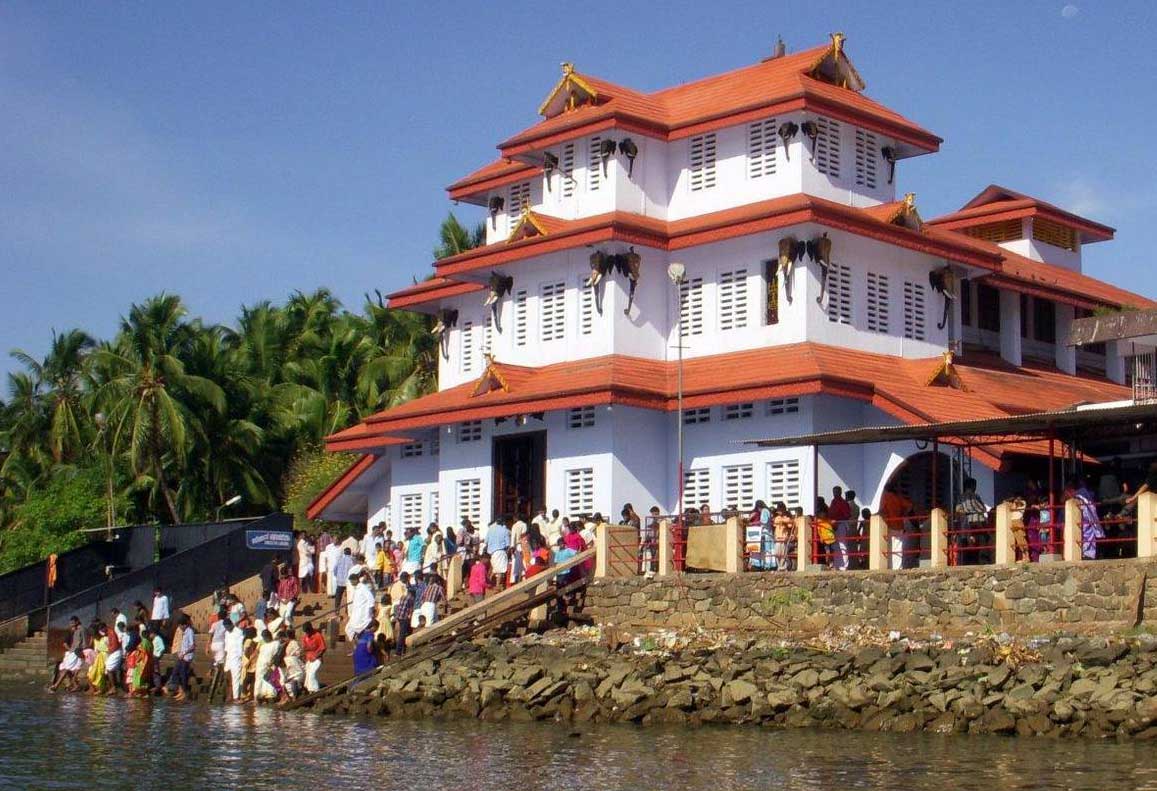
Sharp at 7 pm, the man who I had spoken to came
and opened the red veil and went in and did some small type of puja. In
the meantime I had noticed another man inside a small room being made
up almost like a Kathakali (another unique dance form of Kerala) dancer.
He was obviously the Theyyam! The most noticeable thing about him was
his huge belly which really appeared as if it was a pot which had been
stuck there. He came out and then followed a ritual in which the priest
from inside and the dancer went back and forth making all sorts of
gestures and finally some offerings were made and the Theyyam sat down
on a stool and started drinking some white liquid from 12 “kindis” or
pots with long spouts. He drank through these spouts as if he was using a
straw. I thought it must be milk since it was white in colour but later
found out that it was toddy.
(As has been said before Mutthappan wanted to break away from the traditional Namboodiri worship and allow lower castes to worship in temples. In modern times Sri Narayana Guru who was a great saint belonging to the Thiyya caste who did the same thing and started temples in which lower castes were allowed to conduct pujas much to the chagrin of the Namboodiris who had had a monopoly of rituals in temples for centuries. But as has been mentioned Mutthappan’s temple is unique for other reasons mainly in the type of offerings which are made. Fish, meat and toddy are the customary offerings.)
This dance went on for a long time and eventually he went round the whole group which was standing there in a semi circle facing the deities and touched the people standing in the front row with his sword and waved his red cloth over them and scattered rice over others. It was really a most interesting performance. But what intrigued me most was the appearance of a bitch at the very height of the ritual. She lay in front of him quite unconcerned by the deafening music which was going on. In fact I did notice the moment we entered the temple that quite a few dogs had the run of the place which is something one would never see in any other temple. The bitch lay there without blinking an eyelid and when the offerings were made to a small black stone at one side she ran there and was given a bit of the Prasad. Unfortunately I couldn’t see what it was. But I presumed it must have been a bit of fish or meat. Having got what she wanted she trotted off without a backward glance. She obviously had a brood of puppies waiting to be fed! After the full ritual was over the Theyyam sat in the centre of the hall and everyone crowded round him. I was told that it was customary to ask his advice on all matters and he would give replies and even make prophetic utterances. The crowd jostling around him was too big so I did not like to attempt to go near him.
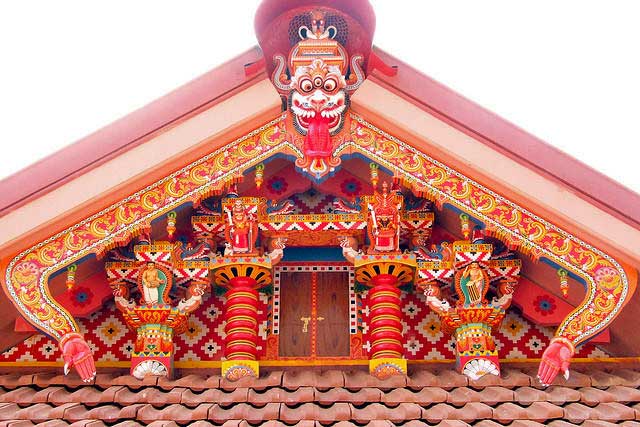
The temple is noted for the charitable services it does to the poor. It runs a free school which gives free food to the children. It also gives free medical service to all.
Thus Sri Mutthappan continues to keep his promise to posterity that he would impartially give succour and aid to the poor, the distressed and the sick. I was indeed grateful to him for having taken me there without any previous planning. Once again before leaving I went to the river and paid homage to her for she was the one who was constantly washing his divine feet as she wound her way to the Arabian Sea. The sun had set long ago and the sky was beginning to fill with a million sparkling lights which lit up the stray boats with thatched roofs and hanging lanterns which wound their way down the river towards their unknown destinations.
Jai Sri Mutthapan
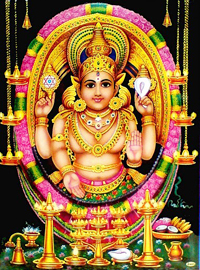
CHOTTANIKKARA AMMA
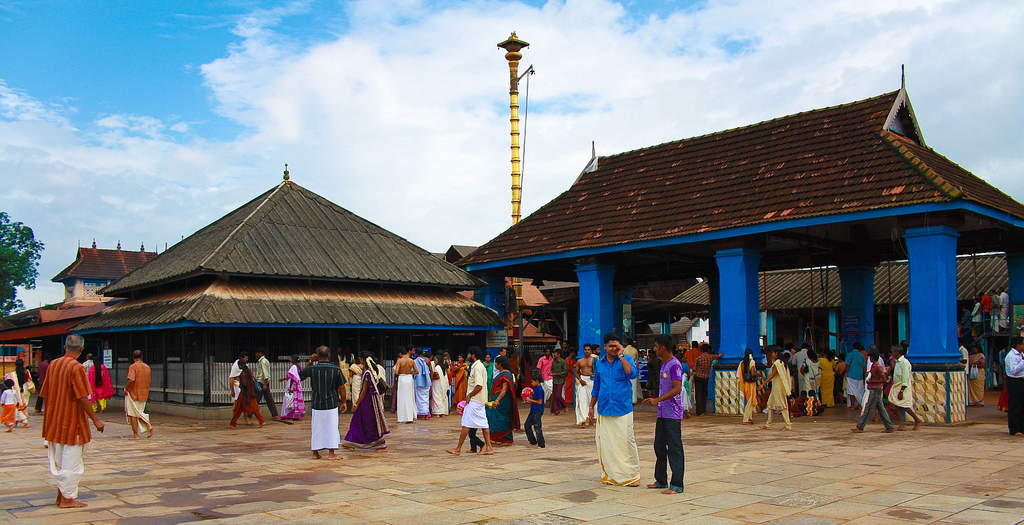
In ancient Kerala, snake
worship and worship of the mother goddess in the form of Durga or
Bhadrakali (fierce form of Kali) was very common. All Hindu families
had a kula daivam (family deity) who was invariably Bhadrakali.
She is variously called as Amma (mother), Devi or Bhagavathi (goddess).
The Chottanikkara temple near Ernakulam is said to be at least thousand
five hundred years old. It is actually split into two halves, the upper
and lower. The Upper has the benign forms of the goddess but the lower
is definitely a Bhadrakali temple.
In the upper temple the idol is made of laterite stone, which abounds in this district and is supposed to be “swayambhu” or self revealed, but we hardly ever get to see it since the priests are adept at decorating it with brilliant colours and jewels.
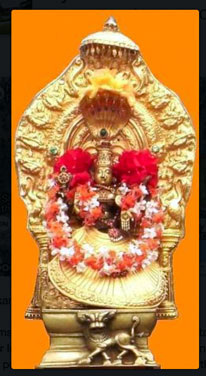
Mookambika Devi in Kollur
Mookambika is
a most famous Devi temple in Kollur, (Karnataka), dedicated to
the goddess Saraswati. She is said to be present in Chottanikkara
when it opens in the morning. Adi Shankara (founder of Advaita) is the
one who had installed Saraswati in the temple of Mookambika and it said
that she had promised him to be present at Chottanikkara in the
morning. So every morning she is dressed in white. For the noon puja
she is worshipped as Lakshmi and is dressed in crimson and for the
evening puja she is seen as Durga and dressed in dark blue. The temple
actually stands on a hillock and is divided into two sections – the
“Melkavu” or upper grove and the Keezh kavu or lower grove. There are
steps leading to the lower grove and a pond separates the two. The
original statue of Bhadrakali is said to have been discovered in this
pond by Vilwamangalam Swamiyar ( a great saint of Kerala). He installed
this in the lower temple or “Keezh Kavu”.
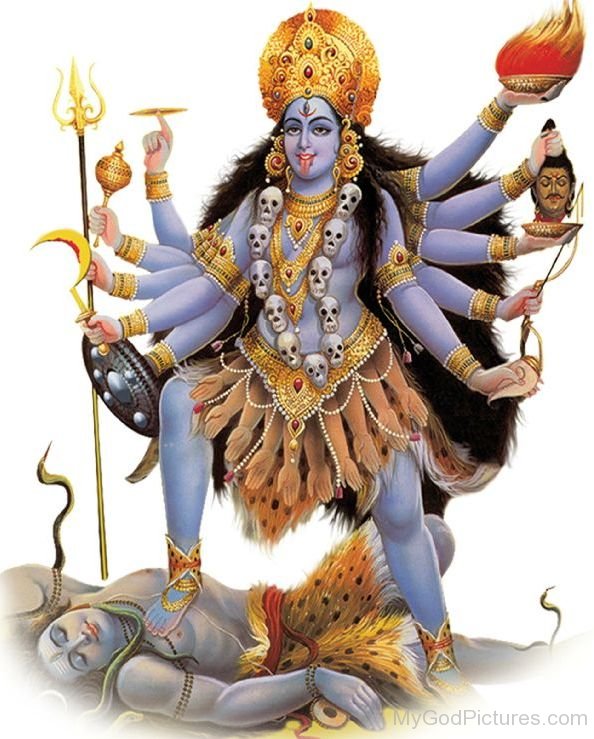
The manifestation of the goddess in the Melkavu is
relatively benign but the manifestation in the Kizhkavu is the
terrifying form of Bhadrakali. She is said to be extremely powerful in
fighting against evil forces. This temple is considered to be the
ultimate healing centre for people suffering from various mental
diseases and even epilepsy, neuralgia, and psychological ailments for
which people normally go to psychiatrists. It is most famous for
exorcising evil spirits.
In the upper temple the idol is made of laterite stone, which abounds in this district and is supposed to be “swayambhu” or self revealed, but we hardly ever get to see it since the priests are adept at decorating it with brilliant colours and jewels.

Mookambika Devi in Kollur

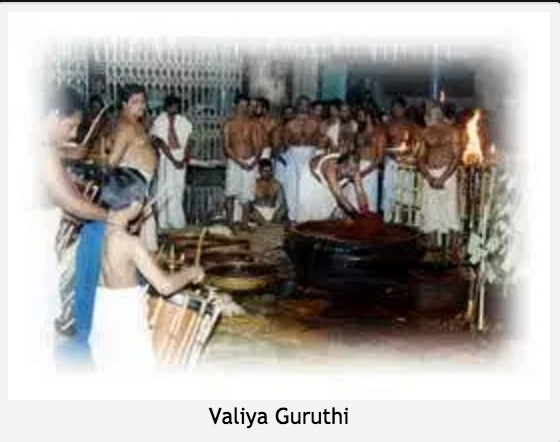
Every night after the
final puja in the evening in the upper grove, the chief priests of the
temple go to the Kizhkavu to perform the famous puja known as Valiya
Guruthi or the great sacrifice. Twelve mud pots are filled with a blood
coloured liquid known as guruthi. It is prepared out of turmeric and
lime water which when mixed turns into a liquid resembling blood.
The priest offers this water to Bhadrakali and sprinkles it round the
temple thus creating a gory environment.
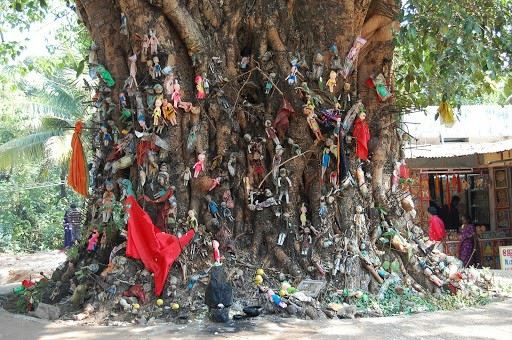
The place has an eerie look. There is a huge pala tree on
one side filled with huge nails which have been flattened into the bark
of the tree. Apparently this was done in olden times by people
possessed by evil spirits. They would drive the nail into the tree
using their heads as a hammer. The tree is filled with bloody streaks.
As a child, when my mother used to take me there I would shiver with
fear and cling to her and try to avoid the scary tree. During the day
this temple hardly seemed to have much to scare you but it comes alive
at twilight when the shadows cast by the oil lamps flicker and wave as
if they were under the orders of some spirit. This was the time when
she was offered the blood of animals and birds. Now the blood has been
replaced by “guruthi”.
The priest comes down and enters the temple and closes the
door with a clang of bells which adorn the door. Many people, mostly
women supposed to be possessed by evil spirits sit around the temple
sometimes emitting strange sounds like growls and sobs. The sudden
opening of the doors of the temple is a signal for these women to jump
up and start shrieking and screaming and howling and crying. The priest
starts to wave a big pot of burning camphor in front of the Devi to the
accompaniment of drums and cymbals and hoots and shrieks from the
possessed. Their hair would be loose and falling all over their eyes
and face. They would roll their heads around with glowing hair lit by
the flickering lamps. They would beat their breasts and shout wild
cries supposedly coming from the spirit imprisoned in their bodies.
Some would roll on the ground in abandon. When the drums reached a
crescendo they would drive nails into the tree by banging their
foreheads on the nail thus nailing the evil spirit forever into the
tree. The spirits do their utmost to resist and shout through the body
of the one it has possessed, “I will not go! I will not go!” But the
goddess is adamant and slowly but surely drives the spirit into
submission. That is when they nail the spirit to the tree with their
heads. It is an unbelievable scene. I had seen it many times as a
child and it never failed to terrify me but my mother would comfort me
and say that this was a boon to these mentally disturbed people who
would get cured by this. The patients were also made to drink the
concoction called “guruthi” which was offered to the goddess at this
time. I have heard that many cures were affected by this treatment.
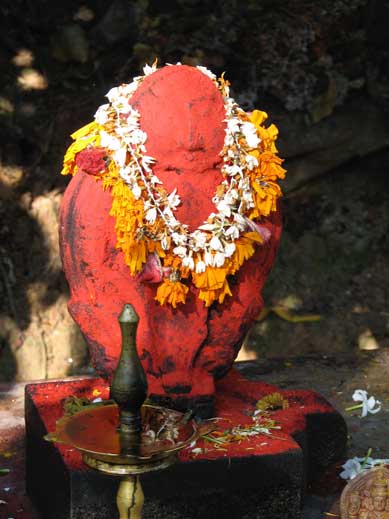
People also offer this guruthi puja to get rid of some
calamity. I was but a child when my mother had this puja done. We were
asked to drink the guruthi and take some back to the house and bury it
in the four corners of the compound so that it would protect the house
and those who dwelt in it from all harm. It would also ward off all
negative influences.
Another important vow which can be made here is to observe something called a “bhajanam”. For this one has to stay on the temple premises and take a bath and attend every puja at the temple starting from 4 am. We are allowed to eat only the prasadam (offerings) from the temple. This is something which I had done myself long ago when I lived in Kerala. Of course I did it only for a week but the mentally deranged would take this vow for forty-one days and in most cases they would be completely cured.


Another important vow which can be made here is to observe something called a “bhajanam”. For this one has to stay on the temple premises and take a bath and attend every puja at the temple starting from 4 am. We are allowed to eat only the prasadam (offerings) from the temple. This is something which I had done myself long ago when I lived in Kerala. Of course I did it only for a week but the mentally deranged would take this vow for forty-one days and in most cases they would be completely cured.
Kerala in the olden days
was a land filled with superstition. It was a land of spirits and
ghosts and man-eating women vampires known as yakshis. They would live
on top of “pala” trees and lure unwary travellers in the night to their
tree top abodes and eat them up. Let us go back to Kerala a thousand
years ago and discover the origin of Chottanikkara temple. The whole
place was covered with a thick, dark, rain forest infested with wild
animals. The only humans who inhabited this place were the tribals who
were almost like the animals. Kannappan was one such tribal who preyed
on unwary people who passed through that forest. Though he was
almost like a beast, he had one human trait. He had a daughter who he
loved very much. In fact he lived and hunted and plundered only for her
sake. One day he happened to spy a man who was walking through the
forest leading a beautiful cow. The cow made a tinkling sound as she
walked due to the silver bells which hung round her neck. Kannappan
pounced on the man and told him to shove off and made off with the cow.
He was delighted with his prize and thought he could make a fortune out
of the cow by selling the meat and the hide. Suddenly the cow gave a
pull at her rope and before he could stop her, she ran off into the
forest. Kannappan gave chase but he couldn’t find the cow anywhere. He
returned despondently to his house and was amazed to see his daughter
fondling and petting the very cow he had been searching for. Seeing his
daughter’s fondness for the cow he decided against killing it.
Unfortunately his beloved daughter died that very night and Kanappan
was left bereft. He lost interest in life and hardly got any sleep. One
night he had a very vivid dream. The goddess with eight hands holding
different weapons appeared to him and said, “Kannappa! Don’t grieve.
Your daughter is in Heaven. I was the cow that you wanted to slaughter.
It was all my play intended for the universal good. I wish to stay here
forever and you shall be my guardian. Kannappa woke up and ran to the
cow shed to find the cow gone. In its stead he found a laterite idol of
the goddess and another smaller one of Vishnu. He felt blessed and
built a small shack around the two idols and started to worship them.
These are the idols which are now to be seen in the upper grove. The
Devi’s idol has four hands, the two above holding the conch and discus
as is seen in Vishnu’s idols and the two below showing the abhaya mudra
and the varada mudra. (Mudras are mystic signs made with the fingers.
The abhaya mudra is one which most idols have and gives us freedom from
fear. The varada mudra grants our wishes.
There is another story
about Kannappa which has a slightly different twist. He was not only a
doting father but a staunch devotee of Kali. Every day he would
sacrifice some animal to Kali. Once he had nothing to sacrifice and was
all set to kill his daughter’s pet calf which she loved very much. The
girl was very upset and preferred to give up her own life to the
goddess. Kannnappa was grief stricken but the calf spoke to him and
revealed that it was indeed the goddess herself who had come to bless
him. Kannappa became a transformed man and started to worship the
goddess at the very place where she had stood.
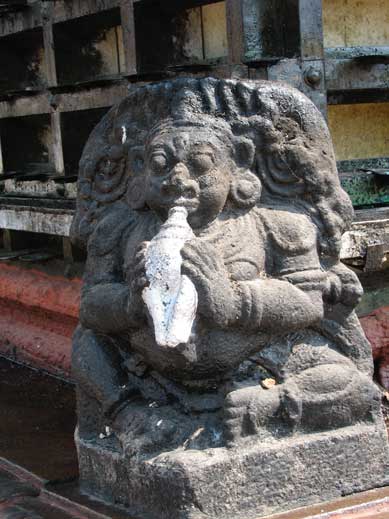
After he died the shrine fell into disuse. Many years passed
until one day a humble grass cutter from a lowly household tried to
sharpen her scythe on this stone and was horrified to find thick, red
blood oozing out of the stone. Her terrified screams brought a lot of
people to the site. They ran to the Namboodiri (Kerala Brahmin) priest
and begged him to come. The Namboodiri felt the energy vibrations as
soon as he neared the stone. He dug out both the stones and found that
one was of Shakti and the other of Vishnu. The Brahmin conclave decided
that they were to be worshipped together as Lakshmi/Narayana. Hence
even today when you go to the temple the air resounds with the mantras
chanted by the devotees, “Amme Narayana! Devi Narayana! Bhadre
Narayana!” This denotes that that the temple has both the powers of
Vishnu and Devi in it.
Edathu Namboodiri was the one who built the first shrine for
the goddess and did all the pujas till his death. This small shrine
eventually became the great Chottanikkara temple we see now.
Interestingly the idol is not fixed firmly to the pedestal as is the
case in all temples. It stands on loose sand. As a result all the water
which is poured over her for abhishekam (ceremonial bath) percolates
through the sand and is believed to join the water of Onakku Bhagavathi
which is further down the way. This sand is said to have great
protective powers. We normally ask the priest to fill a small talisman
with this sand to be put round the waist of small children to protect
them from all harm. I have got these talismans for my children and
grandchildren.
The place where Edathu Namboodiri dug out the idols in the first place is known as the “Pavizhamalli thara”. This is a small platform located to the south of the main shrine on which grows a tree which has lovely flowers.

The place where Edathu Namboodiri dug out the idols in the first place is known as the “Pavizhamalli thara”. This is a small platform located to the south of the main shrine on which grows a tree which has lovely flowers.
Now the temple has many
shrines attached to it. Shiva, Ganesha, Subramanya, Nagas and Shastha
are all to be found here. The shrine of Shastha or Ayyappa is half way
down the steps leading to the Kizhkavu and has a legend of its
own. Once when the goddess was being taken in a procession, they were
attacked by some robbers. The robbers were driven off but in order to
safeguard the procession from harm on their return, Meppazhur
Namboodiri sent his family deity, Shastha along with them. However
Shastha refused to return to Meppazhur and this is the idol which we
see in the shrine today.
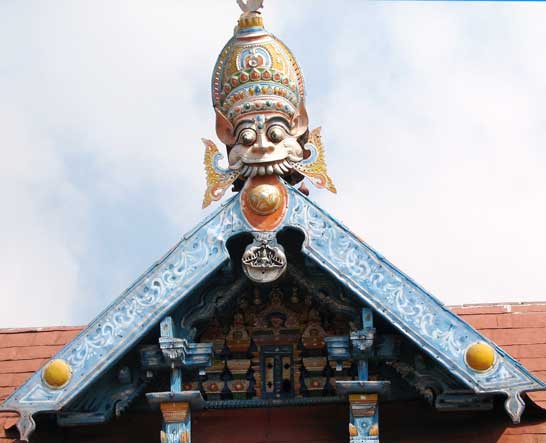
"Kirtimuka "
This year when I was in
Kerala, I was taken to the shrine by Vaasudevan Namboodiri who is
related to the chief priest of the temple. It was another memorable
darshana. We went at twilight which is one of the best times to visit
her. I was allowed to stand on the mandapam (platform) and witness the
entire Deeparadhana or arati. It was quite a spectacular event and I
was so happy to have got this opportunity. It was all Her grace. After
that we went down to the Kizhkav. I was amazed to see the changes which
had taken place. The old eerie looking pond which was in front of the
lower temple had been spruced up and no longer had that mysterious
look. The whole place had been transformed beyond recognition. Instead
of the trees which used to loom along the small path which led to the
shrine, there were spacious halls where pilgrims could relax. The only
thing which had remained unchanged was the pala tree into which nails
used to be driven. I was happy to see it. It brought back vivid
memories about the times I used to visit the temple with my mother,
clinging to her arm, looking around fearfully for lurking ghosts and
spirits. Now with the brilliant neon lights, no self-respecting ghost
would have the guts to hang around. I was sorry. A lot of the magic had
gone, driven in along with the nails into the tree. I looked at the
goddess inside the shrine and I felt that even she had become more
benign, not as fierce as she had been in my childhood. I prayed that
she would dispel the evil forces which seemed to be in danger of
swallowing our whole culture.
Amme Narayana!
Devi Narayana!
Badre Narayana
Amme Narayana!
Devi Narayana!
Badre Narayana
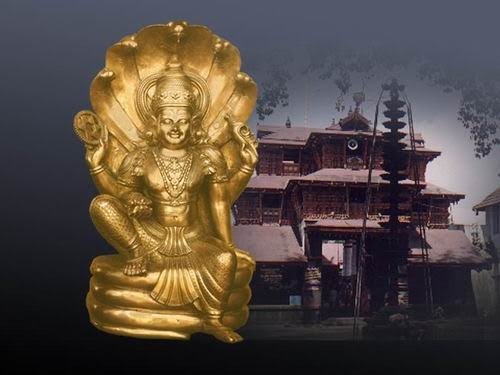
Poornathrayeesan Temple
This time when I went to
Kerala I stayed two weeks in Tripunithura and hence was able to make a
number of visits to this lovely temple of Vishnu. The idol here is
unique. It is a huge idol of Lord Vishnu in a unique sitting posture.
Normally Vishnu is seen as reclining on the divine serpent Anantha but
here the serpent has coiled his body and made a throne for the Lord to
sit on and holds his five hoods as an umbrella over him. The earth
goddess, Bhumi Devi and Lakshmi Devi, the goddess of prosperity are
both to be seen sitting on either side. The sanctum sanctorum in which
the idol is housed is in the shape of a chariot. The whole picture
gives the idea that he is both the provider of all temporal wishes as
well as the giver of salvation.
Tripunithura is 6 kms from Cochin. The palace of the kings of Cochin is situated in this town. In fact Poornathrayeesa the family deity of the Cochin kings. The name literally means One in whom the three Vedas are implicit. It can also mean He in whom all the three gods of the trinity, Brahma, Vishnu and Shiva are to be found. The temple is supposed to be 5000 years old. At that time of course it was only a small structure with tiled roof. In the year 1920 the whole temple except for the west gate (gopuram) was burnt by a fire. The idol was saved by covering it with a mud pot smeared with clay. It was rebuilt in the year 1921 by the great architect Sri Eechara Variar. The western gopuram is said to have been built by divine powers and to this day the age of this structure is not known. It is a two-storied structure with a dais which is supported by eight beautifully carved wooden pillars. It is a mystery how all this wood was not burnt in the great fire.
Tripunithura is 6 kms from Cochin. The palace of the kings of Cochin is situated in this town. In fact Poornathrayeesa the family deity of the Cochin kings. The name literally means One in whom the three Vedas are implicit. It can also mean He in whom all the three gods of the trinity, Brahma, Vishnu and Shiva are to be found. The temple is supposed to be 5000 years old. At that time of course it was only a small structure with tiled roof. In the year 1920 the whole temple except for the west gate (gopuram) was burnt by a fire. The idol was saved by covering it with a mud pot smeared with clay. It was rebuilt in the year 1921 by the great architect Sri Eechara Variar. The western gopuram is said to have been built by divine powers and to this day the age of this structure is not known. It is a two-storied structure with a dais which is supported by eight beautifully carved wooden pillars. It is a mystery how all this wood was not burnt in the great fire.
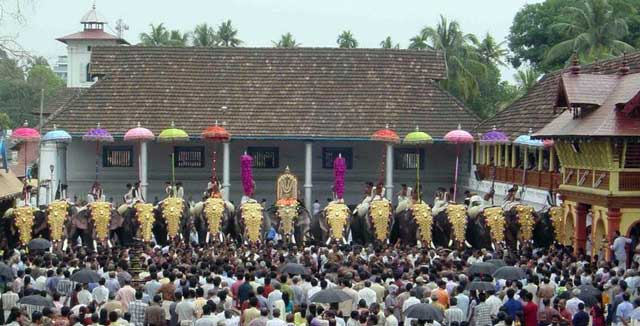
The legend of this temple
goes back to the Krishnavatara. Once Arjuna was visiting Krishna in
Dwaraka and found that a Brahmin had lost nine of his sons soon after
they were born. He kept complaining to Lord Krishna to save his sons
but for some reason the Lord kept quiet and did not heed the Brahmin’s
requests. Arjuna was unhappy about the Brahmin’s accusations to the
Lord and decided that he would take a hand in this. He went to the
Brahmins house and said that he would ensure that his 10th child would
not be still born. He swore that if he did not succeed in this he would
jump into the fire and immolate himself. When the time came for the
delivery Arjuna went to the house and made a cage of arrows round the
delivery room. After some time the Brahmin rushed out, shouting
invectives at Arjuna. Apparently this time even the corpse of the baby
had disappeared. Arjuna went all over the world looking for the baby
and returned dejected. The Brahmin had thoughtfully made a pyre for him
and lit it. He was determined not to be denied the pleasure of seeing
Arjuna burn!! Arjuna took three steps back before jumping into the fire
and found himself caught from the back by Krishna. The Lord scolded him
for not having confided in him. He then took Arjuna to Vaikunta, the
abode of Lord Vishnu where they found all ten children playing around
the serpent bed of the Lord. The latter was happy to see them both and
gave back all the children. The legend goes that this beautiful idol of
Poornathrayeesan was presented to Arjuna by Lord Vishnu himself with
the blessing that the children of all those who prayed to him would be
protected from all harm. So He is also known as Santhaana Gopala or the
Protector of Infants. Krishna and Arjuna now returned to the Brahmin’s
house and gave the children to the happy parents. This Brahmin is
supposed to be a member of Puliyannur Illom, which is the ancestral
home of the chief priest of the temple.
Arjuna is said to have
told Ganesha to look for a good site to keep the idol. Ganesha found
this ancient Vedic village known as Poornavedapuram, Modern
Trippunithura and decided to stay there himself. When Arjuna came he
was quite annoyed with Ganesha and pushed him to the southern side of
the sanctum and installed the idol of Vishnu. Even now we find the idol
of Ganesha is facing south which is very unusual but all the offerings
to Poornathrayeesan are made through this entrance. The village in
those days was filled with sesame (til) fields. Arjuna is said to have
plucked some of the seeds and crushed them and squeezed the oil out of
them and lit the lamp in front of the idol. Even today there is a huge
lamp in front of the idol which devotees believe to be the place where
Arjuna lit the first lamp. It is claimed that there is no offering as
precious to the Lord as a little bit of sesame oil (nallenna) which is
poured into this huge lamp. In due time this place got the
reputation of being able to fulfill the desires of infertile couples.
Later a temple was built
here in memory of this event and as mentioned before the sanctum
sanctorum is built in the shape of a chariot on which Arjuna and
Krishna went to Vaikunta.
Since I stayed two weeks in Trippunithura, I was able to go quite a few times to the temple. A yaga and reading of the Sama Veda was going on which added to the charm of visiting the temple. At one time I was thinking that I still had not tasted any of the prasadam from the temple when someone called me from the kitchen portion on the side and asked me if I wanted any payasam (milk sweet), which is a famous offering here. Of course I was delighted and had a glassful. The last day of my stay I decided to stay till the Deeparadhana (arati or waving of lights) was over. I just don’t know how it happened but I found myself standing on the side, right in front of the idol so that I could see every bit of the arati which I always find fascinating in any temple. I was truly grateful to Him for His grace and prayed for all children, the world over who needed prayers badly- prayed that they would learn to think for themselves and not brain-washed into believing impossible absurdities.
Since I stayed two weeks in Trippunithura, I was able to go quite a few times to the temple. A yaga and reading of the Sama Veda was going on which added to the charm of visiting the temple. At one time I was thinking that I still had not tasted any of the prasadam from the temple when someone called me from the kitchen portion on the side and asked me if I wanted any payasam (milk sweet), which is a famous offering here. Of course I was delighted and had a glassful. The last day of my stay I decided to stay till the Deeparadhana (arati or waving of lights) was over. I just don’t know how it happened but I found myself standing on the side, right in front of the idol so that I could see every bit of the arati which I always find fascinating in any temple. I was truly grateful to Him for His grace and prayed for all children, the world over who needed prayers badly- prayed that they would learn to think for themselves and not brain-washed into believing impossible absurdities.
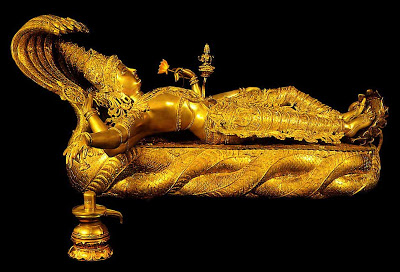
Sri Padmanabhaswamy
Aum Namo Bhagavate Vaasudevaaya